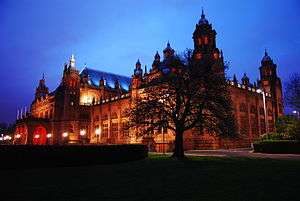Glasgow International Exhibition (1901)
The Glasgow International Exhibition was the second of 4 international exhibitions held in Glasgow, Scotland during the late 19th and early 20th centuries.
Summary


The exhibition followed the lead of the previous Glaswegian exhibition in 1888 and took place at Kelvingrove Park. It ran between 2 May and 4 November[1] and was opened by the Duchess of Fife.[2][3]
It marked the opening of the city's Art Gallery and also commemorated the fiftieth anniversary of the first world's fair held in the UK doubled its attendance with 11.5 million visits.[2]
Exhibits
Following the style popularised at the 1893 Chicago and 1901 Buffalo world's fairs the main exhibition building was in Renaissance-Baroque style. But the large industrial hall contrasted strongly having a large white facade with Spanish, Turkish and Venetian ornamentation and a large golden dome atop.[2] This design by Scottish architect James Miller won him one of his many awards.[4] Countries with close ties to Glasgow exhibited including Japan, Canada and Russia. The Russian exhibition was the largest, a 'Russian village' of 4 pavilions reported to have cost the Tsar of Russia £30 000[2] and included several brightly coloured buildings designed by Fyodor Schechtel.[3]
Whilst Charles Mackintosh's designs for the major exhibition halls were rejected, he did design four pavilions for commercial organisations, and one for the Glasgow School of Art.
Many art works were displayed, including Danae by Edward Burne-Jones, a plaster version of Rodin's Burghers of Calais and 160 works loaned by William Burrell.
Entertainments included a switchback railway, a water chute, an Indian theatre and soap sculptures.
Legacy
The land used is now a park, the 40 foot cast-iron Walter MacFarlane Saracen Fountain from the Saracen Foundry now resides in Alexandra Park and two cottages from Port Sunlight still exist.[5]
Notables
The exhibition took place during a period of half-mourning requested by Edward VII[2] but was still popular and made more than £35000 profit.[6]
Visitors
As well as the opening by the Duchess of Fife, the fair was also visited by the King of Siam and by Empress Eugenie (travelling incognito).[6]
See also
- International Exhibition of Science, Art and Industry (1888)
- Scottish Exhibition of National History, Art and Industry (1911)
- Empire Exhibition, Scotland 1938
- Glasgow Garden Festival (1988)
References
- ↑ "1901 Glasgow". Retrieved 4 March 2011.
- 1 2 3 4 5 Pelle, Kimberley D. "Glasgow 1901". In Findling, John E. Encyclopedia of World's Fairs and Expositions. McFarland & Company, Inc. p. 164. ISBN 978-0-7864-3416-9.
- 1 2 "TheGlasgowStory: International Exhibition, 1901". Retrieved 13 March 2011.
- ↑ "TheGlasgowStory: James Miller". Retrieved 5 March 2011.
- ↑ "historical-buildings". Retrieved 4 March 2011.
- 1 2 Pelle, Kimberley D. "Glasgow 1901". In Findling, John E. Encyclopedia of World's Fairs and Expositions. McFarland & Company, Inc. p. 165. ISBN 978-0-7864-3416-9.
External sources
- http://www.theglasgowstory.com/imageview.php?inum=TGSA00363 image of the opening of the exhibition
| Preceded by International Exhibition of Science, Art and Industry |
World's Fairs held in Glasgow 1901 |
Succeeded by Scottish Exhibition of National History, Art and Industry |